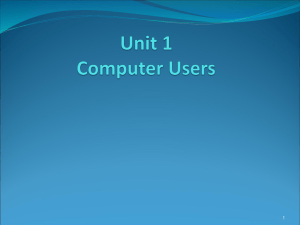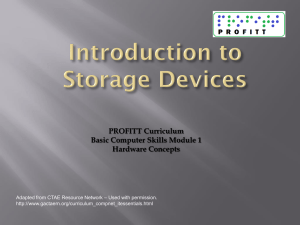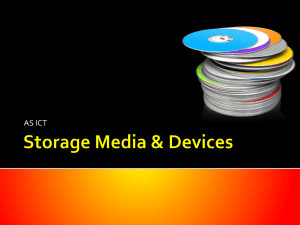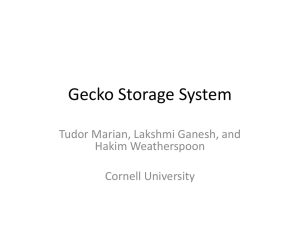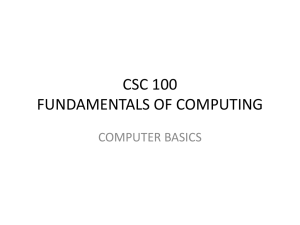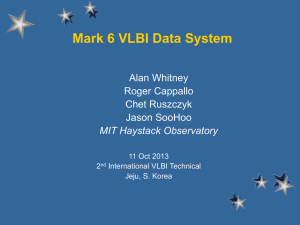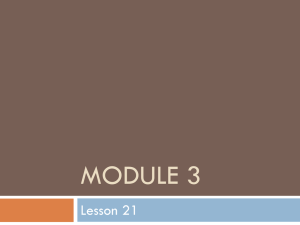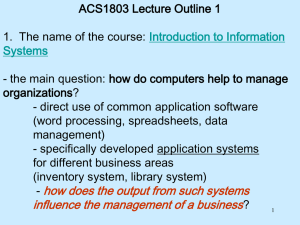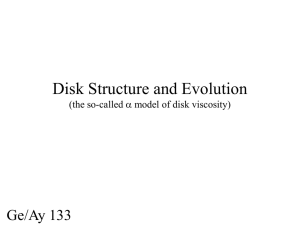Computer Architecture: Types, Components, and Specifications
advertisement
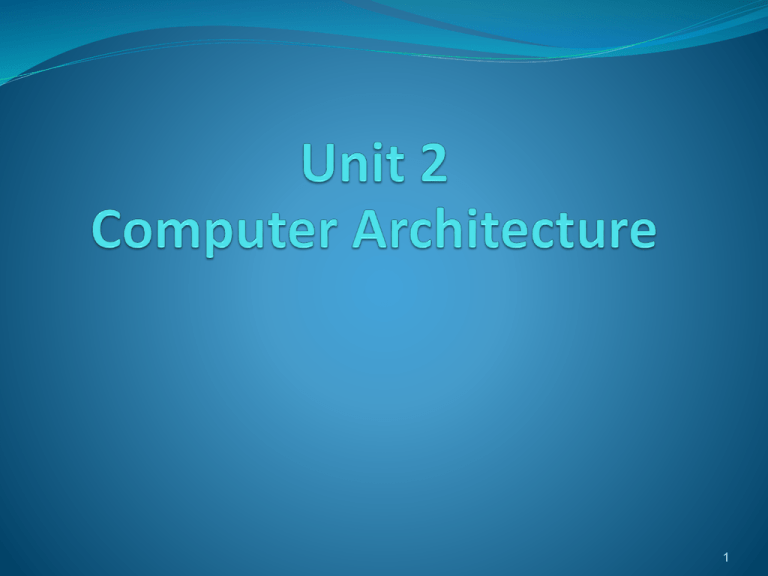
1 Types of Computer: Based on Size and Power Super computer The most powerful type of mainframe Mainframe large, very powerful, multi-user and multitasking Minicomputer smaller than a mainframe, powerful, multiuser, multitasking Personal computer For single user. Has three types: Desktop computer, workstation and portable 2 Mainframe Computers: They are : Multiuser: Can run many programs and process different sets of data at the same time Multitasking: Can be used by many people at the same time 3 Personal Computers: Personal Computers Desktop Computers Suitable size for sitting on an office desk Workstation Most powerful type of desktop, used for graphic design… etc Portable Can be carried around, can operate with batteries 4 Portable Computers: Portable Computers Laptop Large portable, can be rested on user’s lap Notebook Size of a sheet of notebook paper Handheld Can be held in one hand. 5 Handheld Computers: Handheld Computers Pen-based Main input device is an electronic pen PDA (Personal digital assistant): has functions such as task lists, diary, address book 6 PCs and Server computers: The term PC usually refers to an IBM compatible personal computer. An Apple Mac personal computer is not referred to as a PC. Server computer: is a computer on a network that provides services such as storing files and sharing a printer. They usually have a UPS (uninterruptible power supply) attached to them. This is a battery that automatically provides an electricity supply to allow the server to shut itself down properly if the main supply fails. 7 Processors: The processor is the most important part of the computer. It processes the data and controls the computer. Powerful computers used as servers often have more than one processor. 8 Memory: There are two types of memory: RAM (random access memory): It holds the program instructions and the data that is being used by the processor. It looses its contents when power is turned off. ROM (read only memory): It holds the program instructions and settings required to set up the computer . It does not loose its contents when power is turned off. 9 CPU and its Peripherals: Memory + processor = CPU (central processing unit) Sometimes the processor itself is called the CPU. Peripherals: other parts that are connected to the CPU such as: Input devices and output devices. Storage devices. and communications devices. 10 Input/output Devices Input devices Output devices Keyboards, scanners, barcode readers, digital cameras, microphones and video cameras such as webcams (small digital video cameras used on the web) monitors (VDU display screens), printers, plotters, loudspeakers and headphones 11 Storage Devices: • Storage devices are peaces of equipment used for reading from and writing to a storage medium. • Examples: • Magnetic tape, floppy disks, hard disks, CD-ROMs, CD- R disks, CD-RW disks and DVDs. 12 Communication Devices: The common one is a Modem: A modulator/demodulator is a communication device used for converting digital signals to analog signals and vice versa to allow a computer to be connected to an ordinary telephone system. 13 System Bus: A set of connectors used for carrying signals between the different parts of a computer is known as a bus. Data is transferred constantly between the processor and memory along the system bus. Each part of memory has its own memory address and the processor determines where processed data is stored by sending an address signal along an address bus and data along a data bus. 14 Desktop Computer Architecture: In a desktop computer, the CPU and storage devices are normally built inside a system unit which consists of a metal chassis enclosed in a flat desktop or a tower shaped case. Other peripherals are attached to the system unit by cables. Each peripheral uses its own driver card or controller. An expansion card that is plugged into special expansion slots in the system unit 15 Desktop Computer Architecture (Cont.) Expansion cards contain the electronics required to communicate with and control the device e.g. video or graphics cards are used for monitors, sound cards are used for audio input/output and NICs (network interface cards) are used for connecting to other computers in a network. Extra memory can also be added to the computer using special memory expansion slots inside the computer. 16 Portable Computers Architecture: A portable computer that does not have enough space inside to fit expansion cards may use an external device called a port replicator to provide connections for peripherals. 17 Storage Devices: Storage devices in the form of a disk or tape are used to store the programs and data that are not being used Before a program or data can be used, it must be transferred from the storage device to the main RAM memory. 18 Hard Disks Architecture: Hard disks consists of a set of magnetic coated metal disks that are vacuum-sealed inside a case to keep out the dust. The magnetic surfaces of the disks are formatted using a read/write head to provide magnetic storage areas. These storage areas form concentric circles called tracks and each track is subdivided into sections called sectors. 19 Hard Disks Architecture (Cont.) The disks are rotated at high speed and read from or written to by the read/write head that moves across the surface of the disks. In server computers, hard disks can be connected together and made to operate as one unit using RAID (redundant array of inexpensive disks). This can speed up the system and provide a way of recovering data if the system crashes. Fails suddenly and completely, usually referring to a hard disk failure 20 Storage Devices: There is a variety of optical storage devices that use laser light to read or write to a disk, including: CD-ROMs (compact disk read only memory), CD-R (recordable compact disk), CD-RW (rewritable compact disk), DVD ( digital versatile disk) 21 Barcode Reader A barcode reader is a special kind of scanner for reading barcodes. A set of printed bars of varying thickness that are used to identify a product e.g. used to price items in supermarkets 22 Computer Power: When comparing computers, the power of the computer is important. It is determined by the speed and capacity (size) of each part of the computer. Speed is measured in hertz (Hz) i.e. cycles per second. Capacity is measured in bytes (B) where 1 byte = 8 bits (binary digits) = 1 character. 23 Computer Specifications: When specifying a computer, the following are normally quoted: 1. 2. 3. 4. 5. Processor speed (MHz- megahertz, GHz- gigahertz) Memory capacity (MB- megabytes) Hard disk capacity (MB- megabytes, GB – gigabytes) Optical storage devices speed e.g. CD-ROM, DVD (24x = 24 times) Display monitor size (measured in inches diagonally across the screen surface) 24 Computer Specifications: 6. 7. 8. Resolution : the monitor image quality given by the number of pixels (picture elements) that are used across and down the screen e.g. 800 X 600, or by the graphics standard used e.g. VGA (video graphics array), SVGA (super video graphics array) The graphics card memory size (MB – megabytes) Modem speed (measured in kbps – kilobits per second) 25 Numbering Systems: Two different number systems are used in computer specifications: 1) The decimal system, which consists of ten digits from 0 to 9, is used for measuring speed. 2) The binary system, which only has two digits (0 and 1), is used for measuring capacity. 26 Numbering Systems(Cont.) The following prefixes are also used in measurements: Kilo Mega Giga Decimal system 10 3 = 1 thousand 10 6= 1 million Binary system 2 10 = 1024 2 20 = 1,048,576 10 9= 1 thousand million 2 30 = 1,073,741,824 1.7 GHz = one point seven thousand million cycles per second 256 MB = 256 X 2 20 bytes = approximately two hundred and fifty six million bytes 27 Operating Systems: Communication is provided between applications programs and computer hardware by a set of programs called the operating systems e.g. Microsoft Windows, MacOS, Linux. 28 Unit 2 : Computer Architecture Starter 1 A. Supercomputer B. Mainframe C. Workstation D. Desktop E. Portable F. Entertainment console G. Mobile phone 1f, 2b, 3e, 4a, 5g, 6c, 7d 29 Unit 2 : Computer Architecture Starter 2 1) Compact disk read only memory 2) Thin film transistor 3) Megabyte 4) Gigahertz 5) Front side bus 6) Synchronous dynamic random access memory 7) Extended graphics array 30 Unit 2 : Computer Architecture Reading 3 1) 1 GB 2) Hard drive, CD-RW drive 3) 19” 4) 3 GHz 5) 200 GB 6) Microsoft windows xp professional 7) Video card, integrated audio, CD-RW drive 31 Unit 2 : Computer Architecture Language work – Prepositions of place Data moves between the CPU and RAM Data flows from ROM to the CPU A program is read from disk into memory Data is transferred along the data bus The address number is put onto the address bus The hard disk drive is inside a sealed case Heads move across the disk Tracks are divided into sectors 32 Unit 2 : Computer Architecture Problem solving - 7 1) DVD +/- RW drive 2) Memory module 3) APC 1400 Smart-UPS 4) 10/100/1000 Ethernet controller 33 Unit 2 : Computer Architecture Assignment Question 5 page 13 Question B page 17 Writing: 11 page:15 34
